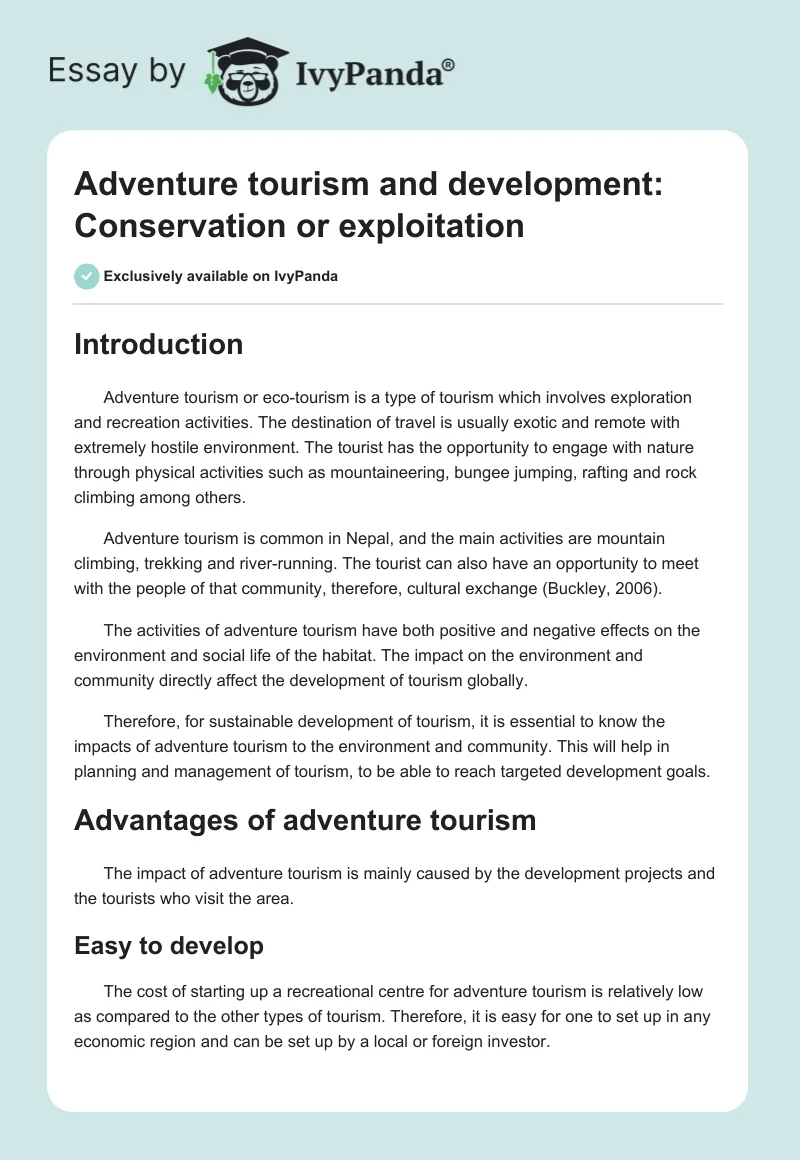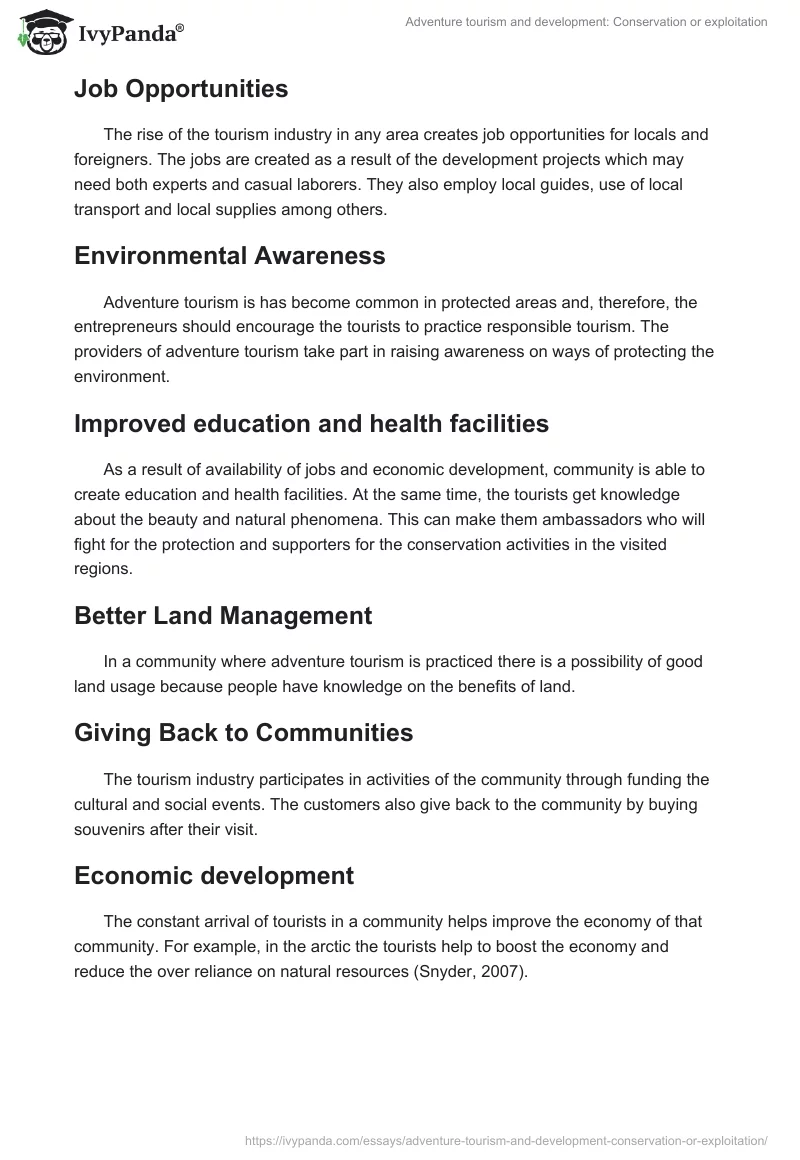Introduction
Adventure tourism or eco-tourism is a type of tourism which involves exploration and recreation activities. The destination of travel is usually exotic and remote with extremely hostile environment. The tourist has the opportunity to engage with nature through physical activities such as mountaineering, bungee jumping, rafting and rock climbing among others.
Adventure tourism is common in Nepal, and the main activities are mountain climbing, trekking and river-running. The tourist can also have an opportunity to meet with the people of that community, therefore, cultural exchange (Buckley, 2006).
The activities of adventure tourism have both positive and negative effects on the environment and social life of the habitat. The impact on the environment and community directly affect the development of tourism globally.
Therefore, for sustainable development of tourism, it is essential to know the impacts of adventure tourism to the environment and community. This will help in planning and management of tourism, to be able to reach targeted development goals.
Advantages of adventure tourism
The impact of adventure tourism is mainly caused by the development projects and the tourists who visit the area.
Easy to develop
The cost of starting up a recreational centre for adventure tourism is relatively low as compared to the other types of tourism. Therefore, it is easy for one to set up in any economic region and can be set up by a local or foreign investor.
Job Opportunities
The rise of the tourism industry in any area creates job opportunities for locals and foreigners. The jobs are created as a result of the development projects which may need both experts and casual laborers. They also employ local guides, use of local transport and local supplies among others.
Environmental Awareness
Adventure tourism is has become common in protected areas and, therefore, the entrepreneurs should encourage the tourists to practice responsible tourism. The providers of adventure tourism take part in raising awareness on ways of protecting the environment.
Improved education and health facilities
As a result of availability of jobs and economic development, community is able to create education and health facilities. At the same time, the tourists get knowledge about the beauty and natural phenomena. This can make them ambassadors who will fight for the protection and supporters for the conservation activities in the visited regions.
Better Land Management
In a community where adventure tourism is practiced there is a possibility of good land usage because people have knowledge on the benefits of land.
Giving Back to Communities
The tourism industry participates in activities of the community through funding the cultural and social events. The customers also give back to the community by buying souvenirs after their visit.
Economic development
The constant arrival of tourists in a community helps improve the economy of that community. For example, in the arctic the tourists help to boost the economy and reduce the over reliance on natural resources (Snyder, 2007).
Disadvantages of adventure tourism
Besides the positive impacts of adventure tourism it also has negative impacts on both the community and the environment. The development through tourism causes impacts which may be particularly harmful to the region and its environment, for example, pollution from the hotel industry, construction activities and tourist activities.
- Economic impact: the cost of responding to environmental effects is usually high for the community. For example, oil spill and lack of equipment to deal with emergencies such as fire.
- Social impact: During the peak season of tourism, the community’s social norms are affected. The dominant presence of tourists during this season alters the roles and functions of the local institutions such as education and religious. This causes a disruption in the community.
- Cultural impacts: The natural environment and traditional lifestyle are affected by the effects of tourism, therefore, fewer tourists hence economies of scale. The loss of artifacts which are later sold to international markets cause loss of cultural heritage.
- Environmental effect: The tourists, for example, in Nepal may litter the environment with plastic bottles and tissues, which is supposed, to be protected and the pollution of water from the waste from hotels. For example, in Nepal firewood is used as a source of fuel for cooking. The effect of cutting trees causes soil erosion and extreme floods (Boniface & Cooper, 2009).
Analysis of the Impacts of Adventure Tourism
Adventure tourism affects the resistance and resilience of the environment. The environment can either resist the effects of tourism or be able to return to normal after being disturbed. For example in Nepal, the culture of the community has not changed because of the tourism activity, whereas, in Thailand the culture has changed causing radical changes in the core of the family.
The most popular cruising location is the Mediterranean followed by the Caribbean. The ocean surfing and diving activities damage the coral reefs in the ocean (Hudson, 2003). The activity of viewing wildlife by tourists causes disturbances on the species.
Some get used to the disturbance by tourists and habituate while others move to more tolerant areas. For example, some nesting birds tolerate only the first few times but later leave their nests for new ones (Pedersen 2002).
Adventure tourism causes soil compaction because of the recreation activities. The activities reduce pore spaces hence lack of air and water infiltration. The end results of soil compaction are loss of vegetation and soil erosion. On the other hand, tourism causes water turbidity through infrastructure and recreation activities. The soil erosion reduces the quality of water, and this affects flora and fauna.
Some animals like the deer have been able to tolerate the presence of humans, whereas the wolves cannot withstand the presence of humans. An example is the rhino in Nepal; the rhinos are not able to feed because they spend a lot of time staying alert when tourists are viewing them. The fact that rhinos move from an area of plenty to an area of less food has affected the reproduction of the rhino.
The impacts of adventure tourism are caused by the various activities of tourist such as rock climbing disturbs birds, diving damages coral reefs, and hiking causes soil disturbance. The deforestation and disruption of the environment causes environmental depletion.
Tour drivers are always in search of rare species; however, the vehicles they drive disrupt the grass cover hence affecting the animals and plants that depend on the grass. The motorboat propellers also kill the manatees in the water and cause pollution of the water.
The economic benefits of adventure tourism have not been adequately distributed in the local communities. In some areas where tourism has had high returns, only a few of the locals benefited, for example, in Thailand the national park collects revenue, but very little of it benefits the surrounding community.
In Nepal, the benefits of tourism development are not spread evenly in the community but is only concentrated in a few areas (Pedersen, 2002).
The impacts of adventure tourism have changed the habitat of several habitats and destroyed the fragile ones. Entrepreneurs have changed the means of transport in these areas; motorized vehicles are no longer used in sand dunes and desert.
To conserve marine life well-trained divers who are less likely to damage the coral reef are responsible for training tourists in diving. The mountaineers have also found ways of camping in areas where they cause less damage than in areas where they disturb the habitats.
When watching whales tourists are advised to keep a distance so as not to disturb and stress them. Tourists and tour guides need to be trained on how to behave when around animals and vegetation so as not to affect them (Brandon, 1996).
Solutions
To reduce the impact of adventure tourism on the environment by maximizing economic and environmental benefits and at the same time minimizes damage to the environment and disrupting the local communities.
- Adventure tourism should keep the number of tourist visiting protected areas at minimal level to maintain the reliability and liveliness of the area. The tourist should use tools and materials that will not damage the area. At the same time the providers of accommodation in this area should use renewable energy and construct on the outskirts of the protected areas to reduce the amount of pollution and damage.
- Involving the local residents in community based projects and training them in basic skills to reduce the level of exploitation. The government should also ensure that the revenue collected is retained in the area, and encourage members of the community to participate in activities in the area. The government and adventure tourism operators may work together with conservationist in training and funding conservation projects (Nash, 2001).
Conclusion
Despite the effects of adventure tourism and lack of benefits to the surrounding community, the people still support tourism development. Some local communities accept adventure tourism if only they shall benefit directly, whereas, others believe that the positive impacts are more than the negative impacts.
For example, in Austrian Alps the cost of basic commodities is high and high taxes but the community has a positive attitude towards tourism.
The impacts of adventure tourism cause a community to embrace tourism while another rejects the tourism industry. The benefits and conservation of tourism can only exist if the local community will benefit economically.
References
Boniface, G, B. & Cooper, C. (2009). Worldwide Destination & companion book of cases set. Massachusetts: Elsvier Linacre House.
Brandon, K. (1996). Ecotourism and Conservation: A review of Key Issues. New York: World Bank
Buckley, R. (2006). Adventure Tourism. Massachusetts: CAB International.
Hudson, S. (2003). Sport and Adventure Tourism. New York: Haworth Hospitality Press.
Nash, J. (2001). Eco-Tourism: Encouraging Conservation or Adding to Exploitation? New York: Population Reference Bureau.
Pedersen, A. (2002). Managing Tourism at World heritage Sites: A practical Manual for World Heritage Site Managers. Paris: UNESCO world Heritage Centre
Snyder, J. (2007). Tourism in the Polar Regions; the sustainability challenge. New York: UN Environmental Program.


